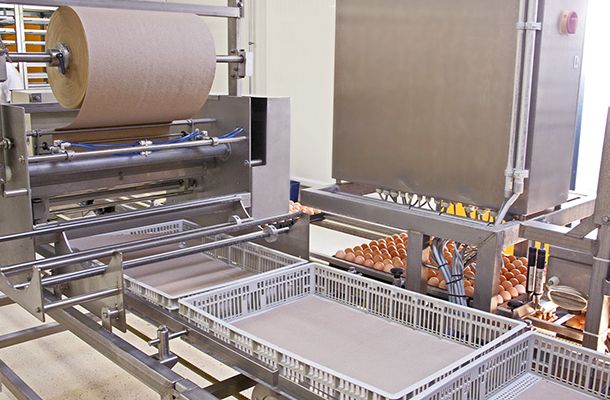Lining hatcher baskets with paper
Tags: Hatching | Whitepaper
, 8 May 2023

In normal hatchery practice, eggs are transferred from setter trays to hatcher baskets at day 18–19 of incubation. It is important that these hatcher baskets are properly cleaned, disinfected and dried to ensure a hygienic start for the new-born chicks. Starting the hatch period with wet baskets will cause a temperature drop due to the energy needed to evaporate the remaining water, which will delay the hatch, widen the hatch window and negatively affect chick quality.
It is not uncommon to see these basic conditions not being met. The reasons for this are:
- Poor washing process: hatcher baskets pass too quickly through the washing machine, worn-out nozzles, low water temperature, not enough detergent, etc.
- Dirt: disinfection is only effective on a clean surface!
- Insufficient drying time until next transfer: this is especially a problem when using the hatching baskets intensively (‘hatch in the morning, transfer in the afternoon’). The drying time can be reduced by increasing the air flow over the wet baskets, ideally in empty hatchers set to ‘drying mode’ to avoid unnecessary alarms.
In situations like this, not only are the hatch results compromised, but increased first week mortality can also be expected.
The best way to address these issues is to tackle the root cause and optimize the washing, disinfecting and drying process, and perhaps invest in an extra set of hatcher baskets.
Some hatcheries choose to keep the hatcher baskets clean during the hatching process by lining them with paper prior to transfer. While this does not remove the need to wash the baskets after a hatch, it will be much easier to clean them properly, which is essential for successful disinfection. Another valid reason for applying paper would be to deal with batches of eggs with a higher number of potential ‘exploders’, as the paper prevents the bacteria-loaded mess from dripping into the baskets below.
Advice
- Understand that hatcher baskets are designed to be used without paper. Depending on the brand of hatcher, the holes in the bottom of the basket could play an important role in ensuring a sufficient airflow over the eggs and hatched chicks. Find out from your incubator manufacturer whether the bottom of the baskets can be covered.
- Only consider lining hatcher baskets with paper if good cleaning results cannot otherwise be guaranteed. An exception is when transferring a batch with too many exploders.
- Understand that the rule ‘hatcher baskets should be dry’ still applies when using paper.
- Ensure the paper lies flat in the bottom of the baskets, as it will otherwise hamper the airflow over the eggs. The paper should therefore be slightly smaller than the basket.
- Ensure the paper is evenly covered by eggs to avoid an ‘empty’ part of the paper lifting due to the airflow in the hatcher and being folded over the eggs.
- Use rough paper with sufficient ‘grip’ for the chicks feet to avoid splay-legged chicks. Newspaper is not suitable!
- Use highly absorbent paper to catch the dirt from exploding eggs.
- Accept the extra costs and issues with the automation of handling hatch residue.
Written by Gerd de Lange
Senior Poultry Specialist
I welcome your feedback on this article - and if you require any additional information, please don't hesitate to contact me.